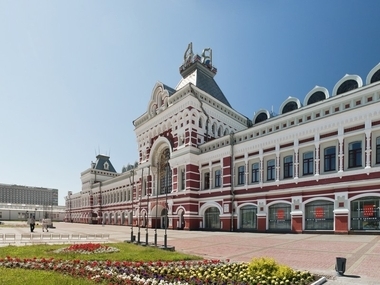In 1816 the olden site of Makariev trade fair nearby Makarievsky Monastery was destroyed by fire. The government took the decision not to restore the location site, but transfer all trade to Nizhny Novgorod, as initially planned, for a trial period. The local authorities did their best so the merchants liked the new site. They understood the advantages the city might have from this trade fair permanent location in Nizhny Novgorod.
The designated location was today`s Strelka area, a pointer-shaped piece of land at the confluence of the Volga and the Oka rivers that would be convenient for the goods delivery buy waterways, with enough water supply for both household needs and fire fighting.
The Emperor Alexander I ordered to suspend the reconstruction of the Winter Palace and redirect a half million rubles for the construction of this trade fair facilities. The works started in 1817, by 1822 trade was already carried out in those new buildings. Nizhny Novgorod gained, in fact, an enormous resource in terms of international trade and recreation facilities. Broad cobble-paved roads with night lighting and advanced sewerage, the latter being first project in Russia and in Europe (a similar facility was built in Paris only a few years later); the trade fair complex was well-equipped with the latest technology of the time.
Active trade operations were carried out only two months a year, however, this relatively short season attracted hundreds of thousands of visitors, ten times more than total population of that time Nizhny Novgorod. The goods were brought here not only from all over Russia, but also from all over the world. According to the olden-time Russian tradition, the shopping arcades were placed in rows, arranged as per activity type and goods. There were rows in meat, flour, bells, mittens, icons, tobacco, waste wood and so many others. The number of minor shops exceeded five and a half thousand, with another seventeen thousand big shops and commercial warehouses.
The First World War painfully hit the welfare of Nizhny Novgorod. The trade activity was still there, but the turnover dropped. In the off-season the troops were stationed in this complex territory and numerous refugees were cooped up in this area. After the revolution Nizhny Novgorod Soviet city council ordered for the termination of all and any monetary transactions at the fair. Goods were allowed to be exchanged for food only. The commercial activity degraded, then for a short while in the years of the New Economic Policy (NEP) the trade somewhat revived, yet in 1930 this trade fair site was finally closed as a "socially hostile phenomenon", and for the next forty years the district was in desolation. Only in the 1970s the big shopping center gradually recovered and today Nizhny Novgorod Trade Fair complex hosts various exhibitions, forums and cultural events.
